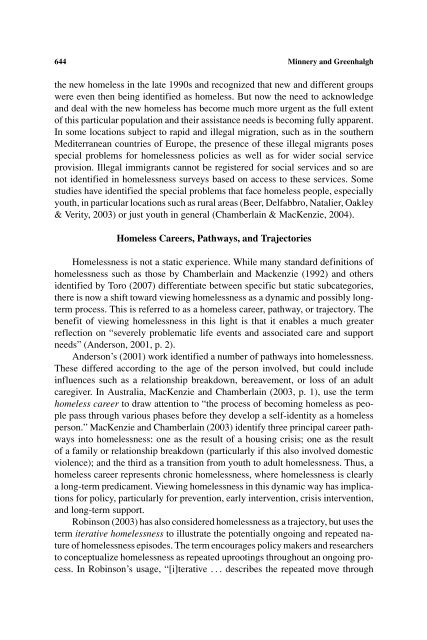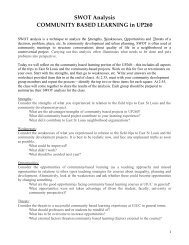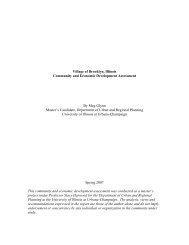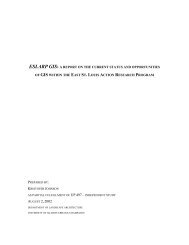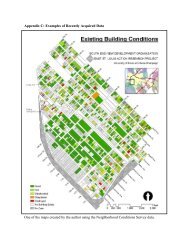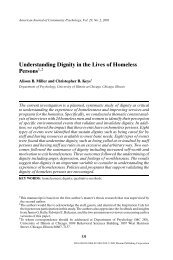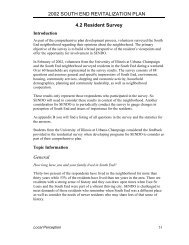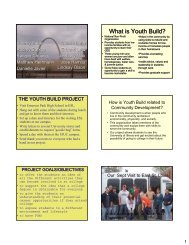Approaches to Homelessness Policy in Europe, the United States ...
Approaches to Homelessness Policy in Europe, the United States ...
Approaches to Homelessness Policy in Europe, the United States ...
Create successful ePaper yourself
Turn your PDF publications into a flip-book with our unique Google optimized e-Paper software.
644 M<strong>in</strong>nery and Greenhalgh<strong>the</strong> new homeless <strong>in</strong> <strong>the</strong> late 1990s and recognized that new and different groupswere even <strong>the</strong>n be<strong>in</strong>g identified as homeless. But now <strong>the</strong> need <strong>to</strong> acknowledgeand deal with <strong>the</strong> new homeless has become much more urgent as <strong>the</strong> full exten<strong>to</strong>f this particular population and <strong>the</strong>ir assistance needs is becom<strong>in</strong>g fully apparent.In some locations subject <strong>to</strong> rapid and illegal migration, such as <strong>in</strong> <strong>the</strong> sou<strong>the</strong>rnMediterranean countries of <strong>Europe</strong>, <strong>the</strong> presence of <strong>the</strong>se illegal migrants posesspecial problems for homelessness policies as well as for wider social serviceprovision. Illegal immigrants cannot be registered for social services and so arenot identified <strong>in</strong> homelessness surveys based on access <strong>to</strong> <strong>the</strong>se services. Somestudies have identified <strong>the</strong> special problems that face homeless people, especiallyyouth, <strong>in</strong> particular locations such as rural areas (Beer, Delfabbro, Natalier, Oakley& Verity, 2003) or just youth <strong>in</strong> general (Chamberla<strong>in</strong> & MacKenzie, 2004).Homeless Careers, Pathways, and Trajec<strong>to</strong>ries<strong>Homelessness</strong> is not a static experience. While many standard def<strong>in</strong>itions ofhomelessness such as those by Chamberla<strong>in</strong> and Mackenzie (1992) and o<strong>the</strong>rsidentified by Toro (2007) differentiate between specific but static subcategories,<strong>the</strong>re is now a shift <strong>to</strong>ward view<strong>in</strong>g homelessness as a dynamic and possibly longtermprocess. This is referred <strong>to</strong> as a homeless career, pathway, or trajec<strong>to</strong>ry. Thebenefit of view<strong>in</strong>g homelessness <strong>in</strong> this light is that it enables a much greaterreflection on “severely problematic life events and associated care and supportneeds” (Anderson, 2001, p. 2).Anderson’s (2001) work identified a number of pathways <strong>in</strong><strong>to</strong> homelessness.These differed accord<strong>in</strong>g <strong>to</strong> <strong>the</strong> age of <strong>the</strong> person <strong>in</strong>volved, but could <strong>in</strong>clude<strong>in</strong>fluences such as a relationship breakdown, bereavement, or loss of an adultcaregiver. In Australia, MacKenzie and Chamberla<strong>in</strong> (2003, p. 1), use <strong>the</strong> termhomeless career <strong>to</strong> draw attention <strong>to</strong> “<strong>the</strong> process of becom<strong>in</strong>g homeless as peoplepass through various phases before <strong>the</strong>y develop a self-identity as a homelessperson.” MacKenzie and Chamberla<strong>in</strong> (2003) identify three pr<strong>in</strong>cipal career pathways<strong>in</strong><strong>to</strong> homelessness: one as <strong>the</strong> result of a hous<strong>in</strong>g crisis; one as <strong>the</strong> resul<strong>to</strong>f a family or relationship breakdown (particularly if this also <strong>in</strong>volved domesticviolence); and <strong>the</strong> third as a transition from youth <strong>to</strong> adult homelessness. Thus, ahomeless career represents chronic homelessness, where homelessness is clearlya long-term predicament. View<strong>in</strong>g homelessness <strong>in</strong> this dynamic way has implicationsfor policy, particularly for prevention, early <strong>in</strong>tervention, crisis <strong>in</strong>tervention,and long-term support.Rob<strong>in</strong>son (2003) has also considered homelessness as a trajec<strong>to</strong>ry, but uses <strong>the</strong>term iterative homelessness <strong>to</strong> illustrate <strong>the</strong> potentially ongo<strong>in</strong>g and repeated natureof homelessness episodes. The term encourages policy makers and researchers<strong>to</strong> conceptualize homelessness as repeated uproot<strong>in</strong>gs throughout an ongo<strong>in</strong>g process.In Rob<strong>in</strong>son’s usage, “[i]terative ... describes <strong>the</strong> repeated move through


